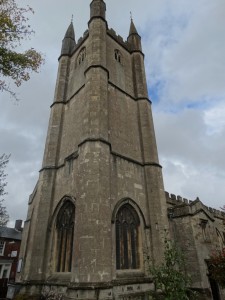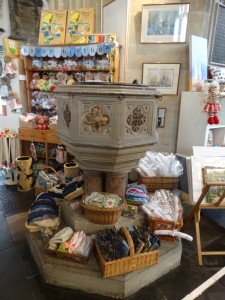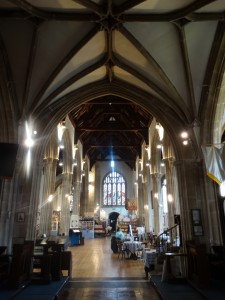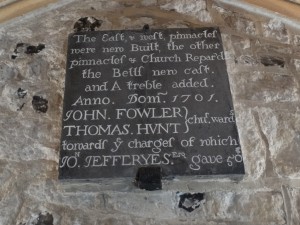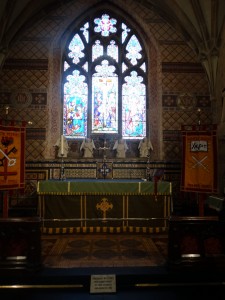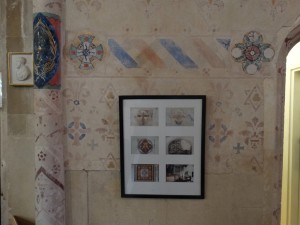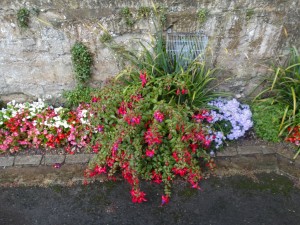We drove along the A4 for a few miles and crossed the county boundary into Wiltshire, entering the town of Marlborough. We found somewhere to park and had a walk along the High Street. A very nice Oxfam bookshop and, at the end of the main drag, what the leaflet describes as “the not-so-redundant church at the west end of the High Street”. The church of St Peter – SU186688. They have a website and you can even see a panorama from the tower.
A church was built on this site by 1100, as within a few years of the Norman Conquest Marlborough had become an important centre of William the Conqueror’s power. A castle was founded, probably in 1068, and this church may have been built to serve those who worked in the castle but lived outside its walls. The first known rector was “Thomas the Chaplain” in 1201. In 1204 the town became a Borough, and Henry III granted permission for an annual St Peter’s Fair. The current church was begun around 1460, the south porch added about 1500. By 1859 it was falling into disrepair, and a lot of work was done. It was joined with the neighbouring parish in 1924, but by 1970 it was in danger of being declared redundant. In 1978 it was handed to a charity. For many years it housed the Tourist Information centre. Major work was done in the 1980s and 90s. Once again I wonder why a church that is officially redundant has so much life. We had an excellent lunch and a wander round the shop. We also had a good explore of the church.
Thomas Wolsey was ordained here in 1498. A quick look at several websites about him – including the one about the blue plaque did not explain why a butcher’s son from Ipswich who was educated at Magdalen College in Oxford was ordained in Marlborough. Northernreader has reviewed Wolf Hall – read her wonderful blog here.
Nice vaulting in the porch and beautiful memorial plaque.
There are lots of fascinating memorials, and it is a shame that some of them are surrounded by the clutter of the 21st century. There is an excellent guidebook to them all. On the left is the Maria Coghill memorial of 1733, which is a very formal memorial with Latin text. The cockerel on the hill may be a pun on the family name. The Hyde Memorial (right) commemorates three of Sir Nicholas Hyde’s children. He was born in 1570, became a barrister at the Middle Temple, became an MP in 1601, and defended the Duke of Buckingham in 1626 against a charge of impeachment by the House of Commons. In 1627 he became Chief Justice of the King’s Bench, and was involved in a number of key political and constitutional cases as the king and Parliament clashed in the late 1620s. He died in 1631. The memorial records the deaths in 1626 of two of his sons, Robert and Francis, within four days of each other, and of one of his daughters, Elizabeth, a month later.
The top one of these three memorials is to Fanny Warner, who died at the age of 45 leaving seven young children. The guidebook comments on the stories we don’t know. The family, or whoever paid for the stone, obviously had money – note the quality of the expensive material. The costly inlaid stone, the varying styles of script, and the gilded laurel leaves. In the middle aile of this sacred place and exactly opposite to this humble stones rest the remains of Fanny Warner with an infant son. To enumerate her many excellent qualities may appear ostentations, not to mention some of them would be ungrateful; suffice it therefore to say, she was one of the best of wives, of mothers, and of friends. She died Oct 22 1779 in the 45 year of her age and left behind her five sons and two daughters, the eldest of whom was too young to feel his loss, the youngest only five weeks.
Here are some more, and there are many, many more I could have photoed.
The Chancel has some lovely tiles, painting of the 1870s, and some good history displays.
The War Memorial Chapel has panelling which was made from the C18 box pews and a reredos carved by Herbert Read of Exeter in 1924. They have been commemorating the WW1 dead of the town by flying their flag at half mast on the anniversary days.
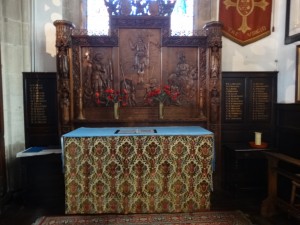 I loved this embroidery and the Rector’s new year message made me smile.
I loved this embroidery and the Rector’s new year message made me smile.


 We liked this Marlborough church, must come back one day and have a closer look at the memorials, and visit the other church.
We liked this Marlborough church, must come back one day and have a closer look at the memorials, and visit the other church.


